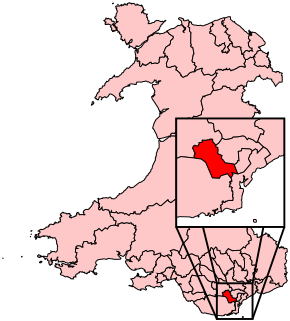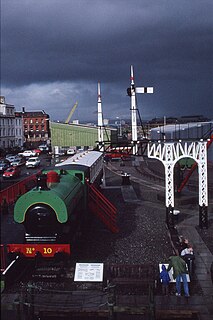
St Fagans is a village and community in the west of the city of Cardiff, capital of Wales. It is home to the St Fagans National History Museum.

St Fagans National Museum of History, commonly referred to as St Fagans after the village where it is located, is an open-air museum in Cardiff chronicling the historical lifestyle, culture, and architecture of the Welsh people. The museum is part of the wider network of Amgueddfa Cymru – National Museum Wales.

Cardiff West is a constituency represented in the House of Commons of the UK Parliament since 2001 by Kevin Brennan of the Labour Party.

Amgueddfa Cymru – National Museum Wales, formerly the National Museums and Galleries of Wales, is a Welsh Government sponsored body that comprises seven museums in Wales:

Fairwater is a district and community in the west of Cardiff, capital of Wales. It is located a few miles from Culverhouse Cross which connects Cardiff to the M4 motorway. The population taken at the 2011 census was 12,981.

Llys Rhosyr, also known as "Cae Llys", is an archaeological site near Newborough in Anglesey; the ruins of a pre-Edwardian commotal court. The Welsh word llys originally referred to an enclosed open-air space but gradually took on the meaning of a place where legal proceedings took place and was gradually extended to refer to royal "courts".

Bute Street is a street in Cardiff, Wales. It links Cardiff Bay and Butetown with Cardiff city centre. It now has no road number. It runs from the dockside of the Mermaid Quay complex in the south, which is now a pedestrian zone, to the junction of Bute Terrace (A4160) in the north.

St Fagans Castle is an Elizabethan mansion in St Fagans, Cardiff, Wales, dating from the late 16th century. The house and remaining medieval fortifications are Grade I listed. The grounds of St Fagans Castle now contain St Fagans National Museum of History.
Iorwerth Peate, also known as Cyfeiliog, was a Welsh poet and scholar, best known as the founder, along with Cyril Fox, of St Fagans National History Museum.

St Teilo's Church is a historic building originally located at Llandeilo Tal-y-Bont near Pontarddulais and now reconstructed at St Fagans National History Museum in Cardiff, Wales.

Kennixton Farmhouse is a 17th-century farmhouse originally built at Kennexstone, Llangennith, Gower, and currently located at St Fagans National History Museum, Cardiff, Wales. It is a Grade II listed building.

Gwalia Stores is a retail premises originally built at Ogmore Vale, Glamorgan, in 1880 and currently located at St Fagans National History Museum, Cardiff, Wales.

Hendre'r Ywydd Uchaf is an early 16th-century cruck house, originally constructed near Llangynhafal, Denbighshire, and now located at St Fagans National History Museum in Cardiff, Wales. One of the interior wooden beams has been dated to the year 1508, using dendrochronology. The house has five bays, two of which would have been used for livestock, and an open hearth. It was designated a Grade II listed building on 10 June 1977.
Pwll-coch was formerly a hamlet in the parish of Llandaff near Cardiff, and is now part of the district of Canton. It was located on the junction of Windway Road and the main road from Cardiff to Ely, a short distance from Ely Bridge.

The House of the Future, more recently renamed Ty Gwyrdd, is a modern house located in the St Fagans National History Museum on the western edge of Cardiff, Wales. Completed in 2000, it was originally a showcase of the latest green building technologies, but was later transformed into an education centre. It was described by architectural writer Owen Hatherley as "a rather ambitiuous gesture for a place devoted to reconstructing the past".

Melin Tregwynt is a woollen mill in the hamlet of Tregwynt in the parish of Granston, Pembrokeshire, Wales. A mill has stood on this site since 1819 taking fleeces from the sheep farms of the area, carding and spinning them into woollen yarn and then weaving the yarn into cloth and blankets. The mill today makes a line of upmarket blankets, cushions, clothing and accessories.
John Geraint Jenkins, known as J. Geraint Jenkins, was a Welsh maritime historian and historian of rural crafts.

Esgair Moel is a woollen mill, originally built in the early 18th century and now reconstructed at St Fagans National Museum of History in Cardiff, Wales. It was the second historic building to be erected at the museum.

The Welsh Industrial and Maritime Museum was located in Butetown, Cardiff, Wales, prior to the Cardiff Bay regeneration in the late 1990s. The museum formed part of the National Museums and Galleries of Wales, now known as Amgueddfa Cymru – National Museum Wales and the first stage opened in 1977, and it closed just 22 years later in 1998.
















